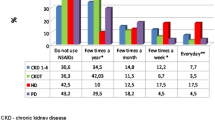Abstract
Canadian Consensus guidelines regarding appropriate use of nonsteroidal anti-inflammatory drugs (NSAID) were recently published. This study was done to evaluate the application of these guidelines on NSAID practice patterns in frail elderly patients referred to a specialist Geriatric Assessment Clinic. A retrospective chart review was undertaken of referrals who were currently prescribed NSAIDs. Data were captured on age, sex, weight, diagnoses, medications and dosages, indication for NSAID treatment, lying BP (as assessed in the clinic) and recent serum creatinine result. Creatinine clearance was subsequently calculated use the Cockcroft–Gault equation. Complete data were available on 107 patients (68% women, average age 80.6 years). Thirty percent were on a traditional NSAID, the remainder were on a Coxib. Concomitant aspirin was prescribed in 37%. Cytoprotection was being used in 38% and did not increase appreciably in patients with additional risk factors for GI toxicity, i.e., concomitant aspirin usage(35%), and history of GI toxicity (48%). Sixty-seven were taking anti-hypertensive medications, although more than two thirds of these patients were uncontrolled. Newly diagnosed hypertension was present in 19.6%. Calculated creatinine clearance revealed moderate to severe renal impairment in 79% of subjects, although serum creatinine was only elevated in 18%. In total, 70% of subjects were found to have relative or absolute risk factors for NSAID therapy. Given the high prevalence of potential contraindications to anti-inflammatory drug usage in this study, we advocate the dissemination and application of these guidelines in geriatric patients in an attempt to reduce potential morbidity and mortality.
Similar content being viewed by others
References
Tannenbaum H, Bombardier C, Davis P, Russell AS (2006) Third Canadian Consensus Conference Group. An evidence-based approach to prescribing nonsteroidal anti-inflammatory drugs. Third Canadian Consensus Conference. J Rheumatol 33(1):140–157
Tannenbaum H, Davis P, Russell AS et al (1996) An evidence based approach to prescribing NSAIDs in musculoskeletal disease: a Canadian consensus. Canadian NSAID Consensus participants. CMAJ 155:77–88
Tannenbaum H, Peloso PMJ, Russell AS, Marlow B (2000) An evidence-based approach to prescribing NSAIDs in the treatment of osteoarthritis and rheumatoid arthritis: The Second Canadian Consensus Conference. Can J Clin Pharmacol 7(Suppl A):4A–16A
Silverstein FE, Faich G, Goldstein JL et al (2000) Gastrointestinal toxicity with celecoxib vs nonsteroidal anti-inflammatory drugs for osteoarthritis and Rheumatoid Arthritis: the CLASS study: a randomised controlled trial. Celecoxib Long-term Arthritis Safety Study. JAMA 284(10):1247–1255
Whelton A, Schulman G, Wallemark C et al (2000) Effect of celecoxib and naproxen on renal function in the elderly. Arch Intern Med 169:1465–1470
Sonomon DH, Schneeweiss S, Levin R, Avorn J (2004) Relationship between COX-2 specific inhibitors and hypertension. Hypertension 44:140–145
Ray WA, Stein CM, Hall K, Daugherty JR, Griffin MR (2002) Non-steroidal and anti-inflammatory drugs and risk of serious coronary heart disease: an observational study. Lancet 359:118–123
Visser LE, Graatsma HH, Tricker BHC (2002) Contraindicated NSAIDs are frequently prescribed to elderly patients with peptic ulcer disease. Br J Clin Pharmacol 53:183–188
Abraham NS, El-Serag HB, Johnson ML (2005) National adherence to evidence-based guidelines for the prescription of nonsteroidal anti-inflammatory drugs. J Gastroenterol 129:1171–1178
Van Leen MWF, Van Der Eijk I, Schols JMGA (2007) Prevention of NSAID gastropathy in elderly patients. An observational study in general practice and nursing homes. Age Ageing 36:414–418
Catella-Lawson F, Reilly MP, Kapoor SC et al (200) Cyclooxygenase inhibitors and the antiplatelet effects of aspirin. N Engl J Med 345:1809–1817
Huang JQ, Sridhar S, Hunt RH (2002) Role of Helicobacter pylori infection and non-steroidal anti-inflammatory drugs in peptic-ulcer disease: a meta-analysis. Lancet 359:14–22
Loke YK, Trivedi AN, Singh S (2008) Meta-analysis: gastrointestinal bleeding due to interaction between selective serotonin reuptake inhibitors and non-steroidal anti-inflammatory drugs. Aliment Pharmacol Ther 27:31–40
Davis P, Juby A (2007) Osteoarthritis. Therapeutic choices, 5th edn., Chapter 71. Canadian Pharmacists Association, Canada, pp 939–952
Disclosures
None.
Author information
Authors and Affiliations
Corresponding author
Rights and permissions
About this article
Cite this article
Juby, A.G., Davis, P. Utility of published guidelines on the use of nonsteroidal anti-inflammatory drugs in the elderly. Clin Rheumatol 27, 1191–1194 (2008). https://doi.org/10.1007/s10067-008-0952-7
Received:
Accepted:
Published:
Issue Date:
DOI: https://doi.org/10.1007/s10067-008-0952-7



